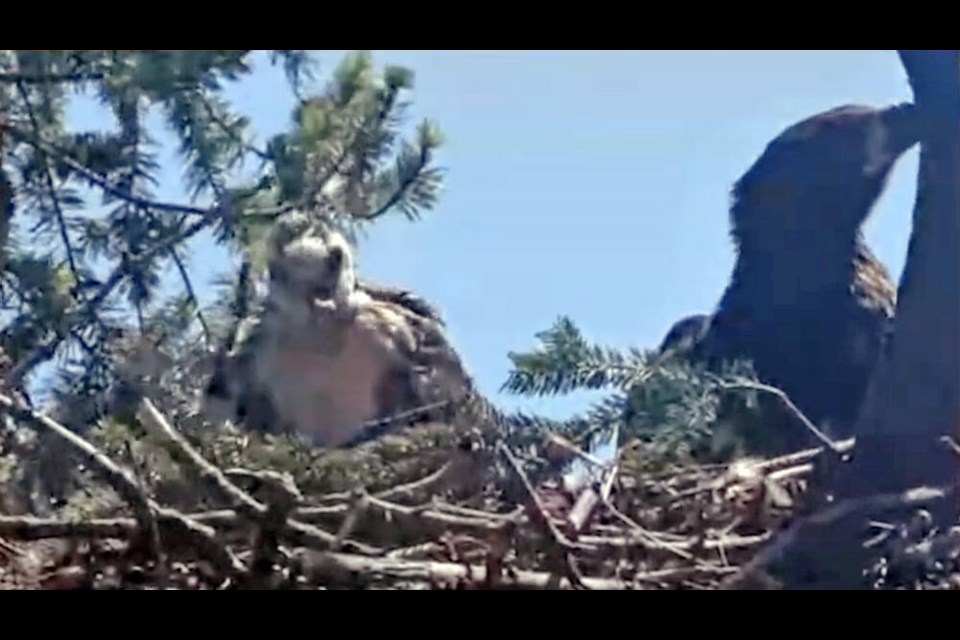High atop a big tree on Gabriola Island, something unusual in nature is unfolding — again.
Bald eagles are raising a red-tailed hawk chick in their nest.
Pam McCartney, a volunteer with Growls, a wildlife rescue society based on Gabriola Island, monitors about two dozen bald eagle nests, including the one with the adopted hawk.
She captured video from a web camera aimed at the nest in Gabriola, showing the moment that one of the adult eagles dropped the live young hawk into the nest.
The bald eagles had two chicks, but one had died.
A similar foster-family arrangement occurred in Sidney in June 2017, when bald eagles raised a red-tailed hawk along with their own brood in a nest in a residential neighbourhood. It happened again in Redding, California, in 2019.
And now the Gabriola case may be shedding light on how these strange blended bird families happen, said David Hancock of the Hancock Wildlife Foundation, an expert on bald eagles.
Hancock said the hawk chicks are taken live as food, but the young hawks — if they are not injured by the eagles grabbing them — manage to survive by immediately making “begging calls for food.”
That prompts the eagles to look down at them, where they notice a similar hooked beak, “and then begin to feed them as one of their own,” said Hancock.
Although the hawk is much smaller “it looks very much like the chick they hatched a few weeks ago,” said Hancock. “If there’s a begging response and it kind of looks like your chick, the parents respond by feeding it.
“It’s a response built into the bird. There’s predator instinct and nurturing instinct.”
Hancock said he has seen many cases of live crow chicks in eagles’ nests “but they eventually get their heads pulled off.”
“In these [three] cases, that didn’t happen,” he said, noting two-red-tailed hawk chicks were taken to the Sidney nest, but one died of infection from punctures from the eagle’s grab. Yet it wasn’t eaten until after the chick died, said Hancock.
Hancock and Christian Sasse, who has videoed all three cases with Hancock over the years, believe eagle/hawk adoptions happen more often than we think — they’re convinced more cases of adoption will appear as the number of eagle-cam nests continues to increase each year.
Hancock said there are reports of at least six other cases, though not on camera, of red-tailed hawk and eagle connections across the country.
Red-tailed hawk chicks are considerably smaller than bald eagle chicks. Adult eagles reach 15 pounds, said Sasse, while hawks are three pounds. But the hawk chicks are feisty, he said.
How the hawk ended up in the Sidney nest had stumped scientists.
At the time, theories varied from the grim and grisly to simple convenience and even dumb luck.
One was the parent eagles took the chick’s hawk mother as prey. As the eagles tore apart her carcass, the egg rolled out to sit with the eagles’ own eggs until hatched.
Another was that the hawk mother was flying when she suddenly had to drop the egg. The first convenient location she lighted upon was the eagle nest while the parents were away.
The theory that gained traction among bird-of-prey specialists, however, was that the eagle parents carried the chick back to the nest as food for their own young, but fed it when it started to beg for food.
A few weeks after fledging, the young Sidney hawk disappeared, never to be seen again.
Hancock said the behaviour of red-tailed hawks raised by eagles hasn’t been documented because the young birds haven’t been banded or fitted with trackers.
In the Sidney case, Hancock placed plastic swimming pools with water at the base of the 80-foot tree and put mice and voles in the pool. The young hawk did what it was supposed to do — hunt rodents — even though it was fed a steady diet of fish from the eagles at the nest.
Hancock’s group monitors about 600 eagles’ nests in the province, where tree-top views have opened a wealth of information for scientists.
“I spent a lifetime looking up with binoculars until the webcams started, and it’s amazing,” said Hancock. “We’re seeing that eagles have a night life, too. They’re busy. We have video of mice crawling in their nests and attacks by owls and raccoons, and now adoptions of little hawks.”
Experts say the phenomenon is not that unusual in nature. The brown-headed cowbird, found across North America, including Vancouver Island, deliberately lays eggs in the nests of other bird species, which then feed and rear the cowbird chick as their own.
The exact location of the Gabriola nest is not being disclosed as residents don’t want any extra activity to disturb the raptors. The public is being warned to stay away as there is no parking, the site is on private property and neighbours in the area are concerned about privacy.
The Gabriola hawk should fledge from the nest sometime in the next three weeks.
As to the little hawk’s name, the consensus among Growls volunteers and locals is Malala, which means “survivor.”
• To view the hawk in the nest, visit growls.ca/eagle-nest-cam/. For a much closer look at the young hawk, visit youtu.be/veERPaz2mSA.



